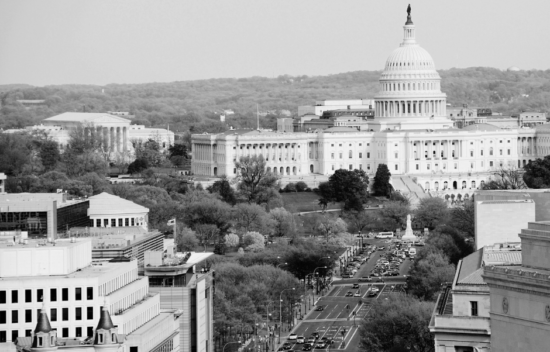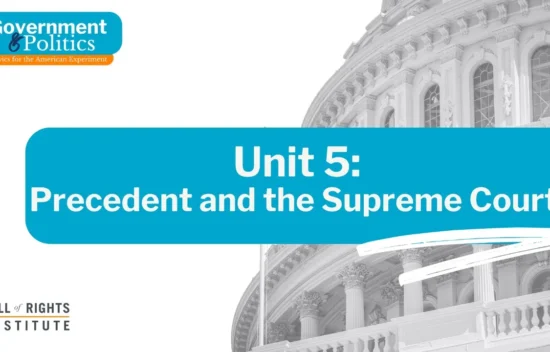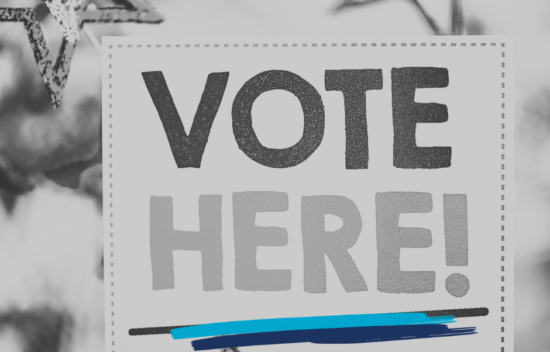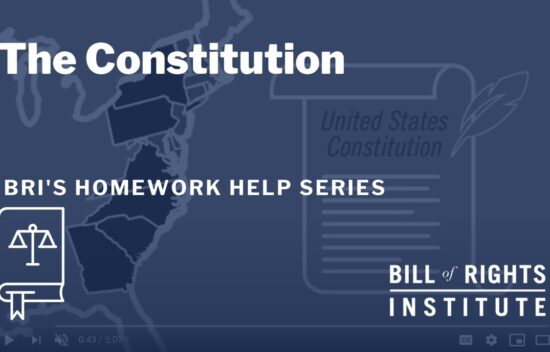Government and Politics: Civics for the American Experiment
Dive deep into the heart of American government with Government and Politics: Civics for the American Experiment, a core resource for on-level and AP Government and Politics classes. Find out how this resource is designed, open our Government and Politics Scope and Sequence, or browse the collection of lessons, activities, essays, videos, and educator resources below.
This dynamic guide for informed citizenry explores the inner workings of U.S. governance and demonstrates the power we all hold in shaping it. Engage students with primary source activities, thought-provoking essays, case studies, critical debates, and immersive game-based learning. Discover the founding principles and civic virtues that fuel the American experiment in self-governance, while developing the knowledge and tools necessary to become active, knowledgeable participants in our democratic society.
7 Units
 Unit
UnitUnit 1: Foundation of American Self-Government
How does the structure of government influence the process of lawmaking and reflect the will of the people?
 Unit
UnitUnit 2: Federalism
How does the division of power and shared responsibilities between federal and state governments affect the authority and purpose of government at each level?
 Unit
UnitUnit 3: The Legislative Branch
How does the structure of government influence the process of lawmaking and reflect the will of the people?
 Unit
UnitUnit 4: The President and the Bureaucracy
What is the legitimate exercise of executive powers?
 Unit
UnitUnit 5: The Judiciary
What is the role of courts in the American constitutional order?
 Unit
UnitUnit 6: Political Participation and Elections
How do we work through existing civic and political institutions to achieve a healthy civic society?
 Unit
UnitUnit 7: Civil Rights and Civil Liberties
How do individuals, groups, and government interact to protect and promote civil rights and civil liberties in the United States?
40 Lessons
 Lesson
LessonWhat are Civic Virtues?
How do civic virtues ensure a healthy civil society and constitutional republic?
 Lesson
LessonCreating a Classroom Constitution
What role does a constitution play in establishing a framework for governing a community, and how does it protect the rights and responsibilities of its members?
 Lesson
LessonPoint-Counterpoint: The Protection of Civil Liberties
Is the Supreme Court the best branch of government to protect civil liberties?
 Lesson
LessonLocke and the Declaration of Independence
How did John Locke’s ideas influence the Founding principles in the Declaration of Independence?
 Lesson
LessonArticles of Confederation
How did the Articles of Confederation limit the effectiveness of the new government?
 Lesson
LessonWhich Level of Government Can Solve This Problem?
Why are different powers exercised at the national, state, and local levels of government?
 Lesson
LessonAngusville Wins a Grant
How does federalism enable local self-government to balance the needs of the common good, address viewpoint diversity, and promote civic virtues within a community?
 Lesson
LessonFederalism in One Day Case Studies
What are past and contemporary (modern) examples of federalism? How does federalism create tension across the levels of government?
19 Videos
 Video
VideoFounding Principles | Government & Politics: Civics for the American Experiment
What are the founding principles that shape the United States? This video explores the foundational ideas that guide American democracy. Learn about the core principles of natural rights, limited government, and the importance of individual liberty and equality, as described in the Declaration of Independence Learn how these principles are translated into the framework of the Constitution, including the separation of powers and the protection of individual rights
 Video
VideoFounding Principles and Civic Virtues | Government & Politics: Civics for the American Experiment
How do founding principles and civic virtues shape the United States? This video takes you on a journey through the foundation of the U.S. Constitution, where ideas like natural rights, limited government, and civic virtues form the bedrock of our society. Discover how these principles—rooted in equality, liberty, and justice—guide self-governance and empower citizens to protect individual freedoms. Learn about the separation of powers, federalism, and the vital role of civic virtues like integrity, respect, and courage in fostering a healthy civil society. From practicing prudence to upholding the common good, see how these ideals enable government accountability and ensure that "We the People" thrive.
 Video
VideoCivic Virtues | Government & Politics: Civics for the American Experiment
What does it take to build a thriving community and sustain self-government? This video explores the essential role of civic virtues in fostering a healthy civil society. Discover how practicing integrity, humility, and respect strengthens our connections and helps navigate the challenges of modern life. Learn how historical figures like Clara Barton, Elizabeth Eckford, and George Washington exemplified these virtues through acts of courage and prudence — and how their monumental impacts began with small, everyday choices.
 Video
VideoIntroduction to Federalism | Government & Politics: Civics for the American Experiment
How does federalism shape the way our government works and impacts our daily lives? From differences in road signs to how schools are run, the structure of the U.S. Constitution ensures that power is shared between national, state, and local governments. But why does this system matter, and how does it address the challenges of governing a geographically large and diverse nation? In this video, explore the principle of federalism, its role in balancing powers, and real-world examples of cooperation and tension among different levels of government. Whether it’s defending the country, managing public health, or ensuring local communities thrive, federalism allows us to tackle big issues together while staying responsive to local needs. This video ties into the Bill of Rights Institute's Government and Politics: Civics for the American Experiment curriculum, specifically Unit 2, which dives into the dynamic dialogue between government levels and the constitutional principles that make it all work.
 Video
VideoIntroduction to the Legislative Branch | Government & Politics: Civics for the American Experiment
What makes the U.S. Congress the cornerstone of our democracy? Dive into the Constitution's Article I, where the framers designed the legislative branch to safeguard liberty while balancing power and passion. This video uncovers the structure of Congress as a bicameral legislature, composed of the House of Representatives and the Senate, each with distinct roles and responsibilities. From shaping laws to tackling debates that influence your education, freedoms, and daily life, Congress is where reason meets passion. Learn how its design fosters deliberation, curbs oppression, and drives liberty in action. This video ties into Unit 3 of the Bill of Rights Institute's Government and Politics: Civics for the American Experiment curriculum. Explore the role of the legislature, the constitutional responsibilities of the House and Senate, and the Supreme Court cases that define representation and redistricting.
 Video
VideoA Day In the Life with Emerald Garret | Government & Politics: Civics for the American Experiment
How do government, politics, and civics work in everyday life? Join Emerald Garrett, a Senior Legislative Assistant as she shares her journey from a young student passionate about foreign languages to Congress. Learn how her unique path and dedication to public service have helped her contribute meaningfully to the legislative process. This video ties into the Bill of Rights Institute's Government and Politics: Civics for the American Experiment curriculum, specifically Unit 3, which examines the purpose and role of the legislature in the Constitution. Emerald's story highlights the importance of young voices in shaping Congress and demonstrates the power of civic engagement in a representative democracy.
 Video
VideoA Day In the Life with Jaydn Smith | Government & Politics: Civics for the American Experiment
How do government, politics, and civics work in everyday life? Join Jaydn Smith a Senior Legislative Assistant as he shares his journey from growing up on a Nebraska farm to Congress. Learn how his passion for public service and dedication to helping his community have allowed him to craft impactful legislation and contribute meaningfully to the legislative process.
 Video
VideoThe House of Representatives | Government & Politics: Civics for the American Experiment
What makes the U.S. Congress the cornerstone of our democracy? The framers designed the legislative branch to be the most powerful—closest to the people, representing their voices, and shaping the laws that govern our nation. But how does the House of Representatives fulfill this role, and why does it matter? Explore the structure of the House, the differences between the House and Senate, and the unique powers that set it apart. From drafting legislation and overseeing the executive branch to ensuring representation through frequent elections, discover how the House reflects the will of the people and upholds the principles of self-government.
 Video
VideoThe Senate | Government & Politics: Civics for the American Experiment
What makes the U.S. Senate a cornerstone of American democracy? Designed as a deliberative body, the Senate ensures stability, represents state interests, and upholds the principles of federalism. But how does it fulfill these crucial roles, and why does it matter? Explore the unique structure of the Senate, its differences from the House of Representatives, and the exclusive powers that set it apart. From confirming federal nominations and ratifying treaties to serving as the jury in impeachment trials, discover how the Senate balances representation and governance—giving every state an equal voice in shaping our nation’s future.
 Video
VideoRepresentation | Government & Politics: Civics for the American Experiment
What makes the U.S. Congress the cornerstone of our democracy? The framers designed it to be the most powerful branch—closest to the people, representing their voices, and shaping the laws that govern our nation. But what does representation really mean, and why does it matter? Learn about the structure of Congress, the differences between the House and Senate, and the models of representation that guide lawmakers. From debate and deliberation to consensus-building, discover how Congress ensures diverse perspectives are heard and why its design is essential to protecting liberty and self-government.
 Video
VideoRules and Procedures of Congress | Government & Politics: Civics for the American Experiment
From committees and procedures to filibusters and cloture votes, Congress relies on a complex system of rules to manage debate, encourage compromise, and shape how laws are made. But how do these rules work in practice—and why do they matter? Explore how the House and Senate organize themselves, the different paths a bill can take, and why most legislation never becomes law. Discover how congressional rules have evolved over time, and how they balance the need for deliberation with the urgency of action in a representative democracy.
 Video
VideoIntroduction to the Executive Branch | Government & Politics: Civics for the American Experiment
From the powers of the presidency to the complexity of the federal bureaucracy, the executive branch plays a critical role in shaping daily life in the United States. But how has this branch evolved over time—and why does it matter for a constitutional republic? Explore the purpose and structure of the executive branch, how the president's powers have expanded, and how executive agencies regulate everything from national defense to children's TV programs. Discover the balance between strong, decisive leadership and the need for restraint, accountability, and civic virtue in a representative democracy. This video ties into Unit 4 of the Bill of Rights Institute's Government and Politics: Civics for the American Experiment curriculum. Examine the evolving nature of the presidency, the function of the bureaucracy, and how the executive branch influences both government and society, while applying constitutional principles and prudence in evaluating executive decision-making.
 Video
VideoThe President and the Constitution | Government & Politics: Civics for the American Experiment
Every four years, the United States demonstrates a remarkable tradition: a peaceful transfer of presidential power. But what exactly are the president’s responsibilities, and how has the role evolved over time? Explore the origins of the presidency in the U.S. Constitution, why the Founders were cautious about executive authority, and the qualifications needed to serve as president. Discover the powers and responsibilities that shape both domestic and foreign policy—from commanding the military and making treaties to signing legislation and appointing Supreme Court justices. Learn how the modern presidency has expanded and why presidential decisions have a direct impact on your life and future.
 Video
VideoThe Bureaucracy | Government & Politics: Civics for the American Experiment
When you think of the executive branch, the president might come to mind—but behind every decision is a vast network of agencies and civil servants. This is the federal bureaucracy. Explore how the bureaucracy functions, from cabinet officials to over 3 million civil service employees. Learn how these institutions have grown throughout U.S. history, how they affect everything from clean water to transportation safety, and why the balance between accountability and expertise is essential in a constitutional republic. Understand the ongoing debate around bureaucratic power, and why this often-unseen part of government has a very real impact on your everyday life. This video ties into Unit 4 of the Bill of Rights Institute's Government and Politics: Civics for the American Experiment curriculum. Examine the constitutional foundations, evolution, and daily impact of the federal bureaucracy—and why understanding it is vital for informed civic participation.
 Video
VideoThe Judiciary Branch | Government & Politics: Civics for the American Experiment
What happens when individual rights come into conflict with school policies—or government actions? In this video, explore how the judicial branch interprets the Constitution and settles real-life disputes that shape how we live, work, and learn. Learn how the federal court system is structured, what powers judges hold, and how landmark cases help define the meaning of liberty and justice in a constitutional republic. Discover why judicial review, the rule of law, and an independent judiciary are essential to protecting the rights of all Americans.
 Video
VideoPrecedent and the Supreme Court | Government & Politics: Civics for the American Experiment
What happens when earlier court rulings shape decisions in today’s most pressing legal battles? In this video, explore how the judicial branch uses precedent to interpret the Constitution and resolve real-life disputes that influence how we live, work, and learn. Learn how the principle of stare decisis—standing by things decided—guides judges in applying consistent standards, ensures fairness, and helps people and institutions rely on the rule of law. From landmark decisions like Mapp v. Ohio to Brown v. Board of Education, see how precedent can both preserve and reshape justice in a constitutional republic.
 Video
VideoPolitical Participation and Elections | Government & Politics: Civics for the American Experiment
What happens when young people step up to shape their communities, states, and nation? In this video, discover the vital role civic engagement plays in a self-governing society—and how individuals of all ages can make a difference, even before they’re eligible to vote. Explore how participating in local boards, volunteering, communicating with representatives, and practicing civic virtues like responsibility and justice strengthen our constitutional republic. From town halls to national campaigns, your actions help uphold the promise of “We the People.”
 Video
VideoElections Essentials | Government & Politics: Civics for the American Experiment
What happens when citizens understand their voting power and engage in the democratic process? In this video, explore the evolution of voting rights in the United States and discover what motivates people to cast their ballots—and why that matters. From the amendments that expanded suffrage to the psychological and structural factors that affect voter behavior, this video explains how elections work and why participation is key. Learn about the Electoral College, congressional elections, and what influences voter turnout.
 Video
VideoCivil Rights and Civil Liberties | Government & Politics: Civics for the American Experiment
What does it take to protect the rights of all citizens—and why does it matter? In this video, explore the foundations of civil rights in the United States and how individuals and institutions work together to uphold them. From constitutional safeguards like checks and balances and the Bill of Rights to landmark amendments and court decisions, this video unpacks how civil rights have been defined, defended, and expanded. Discover the role of civic virtues and citizen action in advancing justice, with powerful historical examples from the Civil Rights Movement and beyond.













































